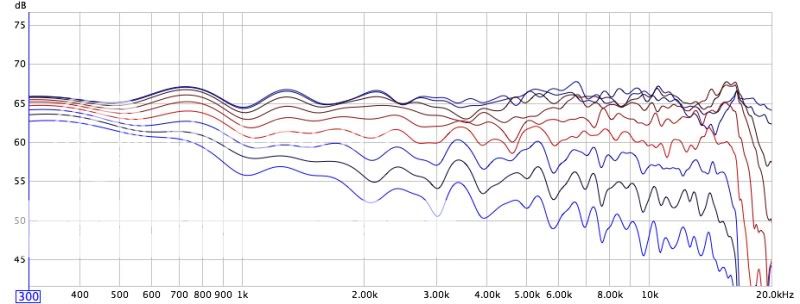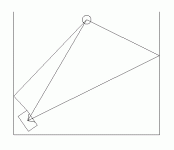Easy for you to say, having recently altered your own view on this, apparently:Seems to me that the opposite is really the case as all of the "experts" seem to be in complete consensus.
http://www.diyaudio.com/forums/multi-way/103872-geddes-waveguides-456.html#post2236387
Am I the only one to have noticed that Gedlee speakers now let the top octave roll down? 😉I think that this question has been well researched and the data points in the direction of a slightly falling direct response with a parallel falling power response. This is the way of nature and it only seems logical that it is what we perceive as natural.
Last edited:
Am I the only one to have noticed that Gedlee speakers now let the top octave roll down? 😉
He is now referencing them off-axis, and isn't displaying the response on-axis (or at varying degrees). You can still see it in the polar intensity map though. (..again, the color difference/magnitude is deceptive for those interested in exceptional linearity.)
Easy for you to say, having recently altered your own view on this, apparently:
http://www.diyaudio.com/forums/multi-way/103872-geddes-waveguides-456.html#post2236387
Am I the only one to have noticed that Gedlee speakers now let the top octave roll down? 😉
I don't see your point because I have not changed my opinion. The link referes to the "width" of the constant directivity NOT to the need for constant directivity. The later is well studied, as I said, but the former is not. No change in my position.
I used to design for flat response, but then recommend that people taper off the high end because, subjectively, flat was deemed to be "bright". I had done this myself for years and you can see this in many of my comments. Now I just roll-off the high end in the product. It just makes more sense to do it that way. Again, no change in position, just a change in implimentation.
They are related. The wider the directivity and the more "constant" it is, the closer it approximates flat power response, which is acknowledged as being "overly bright." The issue is power response and in-room sound power, with a suggestion that some constant directivity designs may broadcast excessive high frequency energy into a small-room listening space, and thus, the frequency response should be tilted down in this region for a more optimum balance. This approach is preferable to controlling the power response with collapsing dispersion, in my view, and for adaption to various room characteristics, should likely be made variable. See Tannoy, et al....
I really can't imagine the top octave plays all that high of a roll in a subjective eval of a speaker. If it did, this speaker would sound bright as can be:

Then look at the average of that graph:

Most definitely not a bright sounding speaker.
On the other hand, this:


I'm sure many would call bright. Obviously, nothing to back this up, but if you've read
http://www.gedlee.com/downloads/AES06Gedlee_ll.pdf
it may be believable.
Dan

Then look at the average of that graph:

Most definitely not a bright sounding speaker.
On the other hand, this:


I'm sure many would call bright. Obviously, nothing to back this up, but if you've read
http://www.gedlee.com/downloads/AES06Gedlee_ll.pdf
it may be believable.
Dan
I find that my first opposite side reflections need to be absorbed. At first I didn't try this because I assumed the opposite ear would separate the reflections.
My sides at this point are different, one diffracts more and one is more reflective. They are 8ms from the direct. They throw off imaging and the reflective side contains a considerable amount of energy.
It occurs to me that the first opposite reflection path is more on axis that my listening axis is, and this concerns me.
My sides at this point are different, one diffracts more and one is more reflective. They are 8ms from the direct. They throw off imaging and the reflective side contains a considerable amount of energy.
It occurs to me that the first opposite reflection path is more on axis that my listening axis is, and this concerns me.
Allen, when you absorb opposite reflections, you also absorb same side reflections. I wouldn't discount that little tidbit in what you are hearing depending on exactly how you are doing it.
When you say diffracts more do you mean diffuses more?
Do you mean that the reflection is closer to you than the speaker?
Probably the wrong thread to get too deep into room issues, but I found your post a bit confusing.
The stuff I posted is regardless of room conditions. However, the more absorptive the room, the less problems you hear with the speaker in my experience. Dr. Toole agrees.
Dan
When you say diffracts more do you mean diffuses more?
Do you mean that the reflection is closer to you than the speaker?
Probably the wrong thread to get too deep into room issues, but I found your post a bit confusing.
The stuff I posted is regardless of room conditions. However, the more absorptive the room, the less problems you hear with the speaker in my experience. Dr. Toole agrees.
Dan
Yes 🙂When you say diffracts more do you mean diffuses more?
No. The reflection points for first same side and first opposite side are in different locations (four side absorbers needed in total).Allen, when you absorb opposite reflections, you also absorb same side reflections. I wouldn't discount that little tidbit in what you are hearing depending on exactly how you are doing it.
My point is simply this. My first same side reflection comes off the front baffle almost perpendicular to it. My listening axis is at around 20 degrees, and the first opposite side reflection leaves the front baffle at 5 or 10 degrees from it.
Therefore, although the first same side is close in time to the direct, and it is also the same ear, the energy is lower. I find this makes each of these type of reflection just as necessary to deal with as each other, in my case. FWIW, subjectively the first opposite side reflection was less damaging to the sound, in and of its own, but the brute force of the magnitude made it a bigger issue.
By the way, I use ARTA. What is the benefit of using the energy time curve? When I measure I get a time/magnitude plot which I'm then expected to convert to a frequency response, or ETC etc. but I find the plain time/magnitude plot easier for locating the spikes that show the reflections.
The wider the directivity and the more "constant" it is, the closer it approximates flat power response,
That is incorrect, but I suspect that you said it wrong, i.e. its not what you meant. The "width" of te directivity has nothing to do with the "flatness" of the "power response". If the directivity is "constant" then the power response tracks the axial response, but that doesn't imply "flat".
It occurs to me that the first opposite reflection path is more on axis that my listening axis is, and this concerns me.
Can you give us a little diagram to illustrate this?
?
The paths we call "the first reflections" (no matter which) must always be right on axis with listening position, no?
The paths we call "the first reflections" (no matter which) must always be right on axis with listening position, no?
Can you give us a little diagram to illustrate this?
Attachments
Can you give us a little diagram to illustrate this?
An externally hosted image should be here but it was not working when we last tested it.
An externally hosted image should be here but it was not working when we last tested it.
Michael
edit
uups - too late...
🙂
Am I the only one that doesn't have a listening chair? I'm all over the place. Anyway, we should probably take this room discussion elsewhere.
Dan
Dan
Anyway, we should probably take this room discussion elsewhere.
Aren't we discussing speaker directivity and the response of waveguides at various axes?
Zilch and Dr. Geddes seem to be.
None the less, the picture is worth a thousand words. I'd say pull you speaker out from the wall and if you have a narrow directivity WG, that reflection shouldn't be too much of a problem in the range of the WG. That said, I'd say get absorption up along that front wall and beside the speaker like a short "U".
FWIW, I'd love to discuss room issues elsewhere.
Dan
None the less, the picture is worth a thousand words. I'd say pull you speaker out from the wall and if you have a narrow directivity WG, that reflection shouldn't be too much of a problem in the range of the WG. That said, I'd say get absorption up along that front wall and beside the speaker like a short "U".
FWIW, I'd love to discuss room issues elsewhere.
Dan
I think your graph shows and interesting issue to consider. Within the directivity path with it's first reflection off the opposit wall, the strength of the reflection might not be less than that caused by out-of-beam first reflections.Aren't we discussing speaker directivity and the response of waveguides at various axes?
So now, the reall complication would be profile of beam and roll-off and it's suitability for different listening arrangements.
Last edited:
Soongsc, I think you are on to something there. Look at these blind subjective ratings of various speakers in 2 positions:
Audio Musings by Sean Olive: The Dishonesty of Sighted Listening Tests
I'd love to know more of the specifics about that test.
Dan
Audio Musings by Sean Olive: The Dishonesty of Sighted Listening Tests
I'd love to know more of the specifics about that test.
Dan
- Home
- Loudspeakers
- Multi-Way
- Geddes on Waveguides
